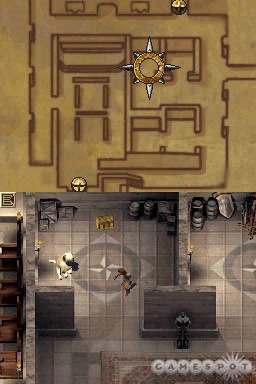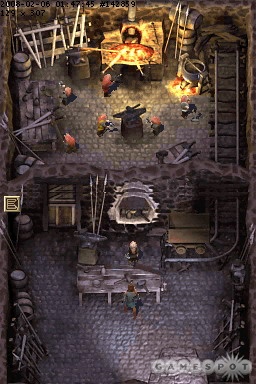The Chronicles of Narnia: Prince Caspian is a light role-playing game for the Nintendo DS based on the movie of the same name. Though it employs interesting timing-based combat mechanics, its repetitive battles, short play time, bad graphics, and senseless item system combine to make a poorly paced experience that quickly goes from decent to dull. Due to its uneven difficulty and lackluster version of the Prince Caspian tale, this game cannot be recommended for children. Its repetitive nature and poor pacing will likely bore adults as well.
The game commits itself to telling the story of its source material, though it does so without gusto. You're no doubt familiar with the Pevensie children from C.S. Lewis' The Lion, The Witch and the Wardrobe, but you'll also be able to control more than a dozen other characters in your repetitive exploits, including Trufflehunter the badger, Reepicheep the mouse, and, of course, Prince Caspian himself. Prince Caspian fights alongside such a motley crew of forest friends because he's been forced to hide in the outlying forest. He has fled his kingdom because his uncle, King Miraz, wants him dead. Caspian's death would clear the way to the throne for Miraz's newly born son. However, Caspian escapes then meets up with a badger and a dwarf to start building an army of fantastical creatures. He inadvertently summons the Pevensie children, and they are drawn into the struggle as well. Even though the game has you flip the DS on its side to mimic the act of reading a book, the plot in Prince Caspian is delivered without style or drama.
The battle system is more interesting. At first glance, the combat scenarios resemble those found in turn-based RPGs, such as the Final Fantasy games. However, characters (friend or foe) can attack at any time, as long as their stamina bar is full. After each attack, stamina empties, and that character must wait to catch its breath before attacking again. To attack a foe, you simply point at one of your heroes with the stylus and then point at an enemy. Once you've successfully entered an attack command, you'll enter a brief minigame corresponding to one of six weapon types. With a bow user, for example, you'll draw back arrows with the stylus and shoot them at bull's-eyes; where you hit decides how much damage is done. When an enemy is about to attack, the earth beneath its feet momentarily turns orange. If you attack within this orange window, you'll cancel your enemy's turn, deplete all its stamina, and do the damage of a normal attack.

The benefit of this system is that you're forced to time your attacks, but the problem is that there's little else to do. Once you learn to preempt enemy attacks by hitting them in their orange circles, you've basically mastered the game and nearly all of the foes in it. The first half hour you spend with this system will be frustrating because the enemies won't wait for you to figure things out before attacking. For a little while after you get the hang of the game, the combat is fun. You're tracing sword slash lines, shooting arrows, and generally kicking butt. But the game and its gameplay quickly enter a deep rut never to emerge because every fight begins to feel the same.
For instance, you'll fight trolls, werewolves, minotaurs, and soldiers, but aside from a few minor details (attack strength, hit points), they are all effectively the same. Their numbers vary from fight to fight, but after a couple of hours, you will have every permutation down pat. Then, you'll start to get really bored because you'll be tired of fighting the same bad guys, yet the game will tell you to backtrack all the way through repopulated areas you just cleared.
Because combat becomes so formulaic, you may not even get around to checking out your usable items until you run into a boss, such as the mother bear. She is only identifiable as a boss because she hits much harder than a normal enemy and is accompanied by a cub. If you hit the cub, she hits even harder. If you avoid the cub and protect yourself with items, she is relatively easy. Though the presence of the cub makes her more challenging than normal enemies, she isn't very fun to fight and might be extremely frustrating for children. The same can be said for most of the bosses, each of which has a minor wrinkle to be ironed out before you can defeat them. These encounters are better than the normal ones, but they still aren't very good.
Items are easy to use--just drag and drop--but they don't always make sense. Apples, for instance, make sense. If you feed one to a character, it will regain health. The armor item, on the other hand, inexplicably weakens your enemies. This weird disconnect between what a thing is and what it does is compounded at the forge. The forge is where you go to increase your characters' attack power. If have the right items, you can trade them in for an upgrade. However, there's no rhyme or reason to what you're after, so you wind up with a bag full of random items, many of which you'll never use.

But you don't just collect items, you also collect playable characters. Though many will simply join your cause outright, others have needs, such as a sick creature that needs you to find a rare red fern. Side quests, such as this one, can lead to a character joining your army, though they generally tend to involve more backtracking, and add no new combat moves outside of the main six. Other extras are provided by the DGamer service, which can perhaps best be described as a Disney version of Xbox Live. As it pertains to Prince Caspian, the service lets you compare your score with other gamers, as well as equip items found in the game to your DGamer avatar. These trimmings could certainly enhance a good game, but if you don't enjoy Prince Caspian in the first place, you aren't likely to care that you can compare your score with people online.
Though he looked good on film, Prince Caspian does not fare so well on the DS. He animates very stiffly, and there's no style or panache in the whole kingdom. The music is just as bad because it cycles without any grasp of context. In the beginning of the game, before the king has ordered you slain, the music is inappropriately heavy, fast, and scary. But then, when you're getting chased out of the castle, the music is calm. It doesn't make any sense.
And spending a ton of time on this DS game might not make a lot of sense either. Though the combat manages to impress in the early going, it's all downhill from there, thanks to the repetitive battles, weak story telling, uninspired bosses, and a seemingly vestigial item system. At about seven hours, the game isn't particularly long either. Though Prince Caspian is not without its charms, the game never lives up to its potential and ends up being too boring and repetitive to live up to the exciting tale it’s based on.
Editor's Note 05/22/08: The preceding review is a re-evaluation of Prince Caspian on GameSpot. The original review contained minor factual inaccuracies and overlooked some features of the game. GameSpot regrets the error.